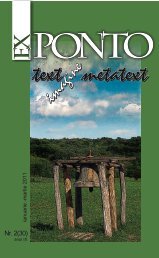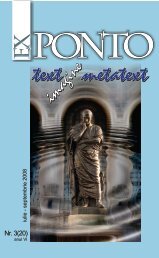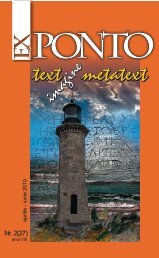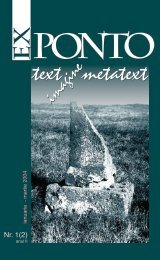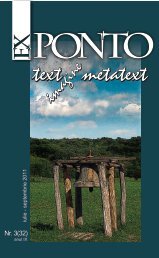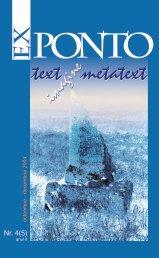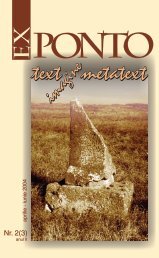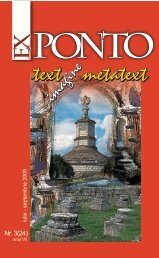Nr. 3 (12) anul IV / iulie-septembrie 2006 - ROMDIDAC
Nr. 3 (12) anul IV / iulie-septembrie 2006 - ROMDIDAC
Nr. 3 (12) anul IV / iulie-septembrie 2006 - ROMDIDAC
- No tags were found...
You also want an ePaper? Increase the reach of your titles
YUMPU automatically turns print PDFs into web optimized ePapers that Google loves.
tries to separate the editor’s domain from the critic’s, he accepts the criticalinvestigations done by the editor when he faces textual alterations and needsto classify them. “Alteration” is not necessarily an erasure, which allows amodification of the text, but it might very well be. For Tanselle, each alterationimplies a change at the level of the authorial intentions and should be takeninto account accordingly.Carrying further Tanselle’s approach, Zeller notices the dangers, whichmay appear when an editor is absorbed in following the “artistic intentions ofthe author”. One of these is the difficulty of preserving the integrity of the wholework, a goal almost impossible to attain. An interesting point is the connectionbetween the authorial intentions and redundancy in the text:To edit the text according to the intention of the author, when the singularitiesof his intention are known to us only through this text, can be achieved only ifthe text is in a certain sense redundant, that is to say, predictable. 13The example of deletions from Crane’s Maggie required by his editor inorder to clean up the text raises a difficult choice for the editor. Crane wasasked to remove “profanity” and “sordid details” which obviously were initiallyintended by the author; then he “softened” the text, creating a second version,which also is a proof of a subsequent set of authorial intentions. To restore thefirst set of authorial intentions means to ignore the whole history of the text andto create a chain of suppositions about a reading, which never happened.Editing Beyond Authorial IntentionsMcGann’s sociological approach to textual topics evidently leads him toredefine “authorial intentions.” Since the published text is the result of constantnegotiations between author, on the one hand, and publishing institutions, onthe other, the author’s authority over the text is no longer unique. The authorshares it with the editorial collaborators who may determine changes in theinitial conception. Under such circumstances, to talk about authorial intentionsis futile. Although, McGann does not completely reject the functionality of theconcept, which can be used among other criteria when the editor selectsthe copy-text of an author, he cannot accept the spread of the conceptindeterminacy over the complex phenomenon of the social authorship.Authorship is a special form of human communicative exchange, and itcannot be carried on without interactions, cooperative and otherwise, withvarious persons and audiences. In these events editors and publishers functionas the means by which a text’s interaction with its audience(s) is first objectivelyhypothesized and tested. 14He analyzes several editorial cases, pointing out the imminent difficultiesan editor may encounter whenever “authorial intentions” are considered centralto the editorial process. Yeats reworked his poems for his Macmillan De Luxeedition, but did not finish the project started in 1931. It took more than half acentury to publish it, and, even though, it was not spared by the critics’ attacks.Filtering the authorial intentions through the immense volume of documentsseemed to be an impossible mission even for Yeats himself who “put manydifferent sets of intentions in motion, and where these intentions often reachedEx Ponto nr.3, <strong>2006</strong>85




